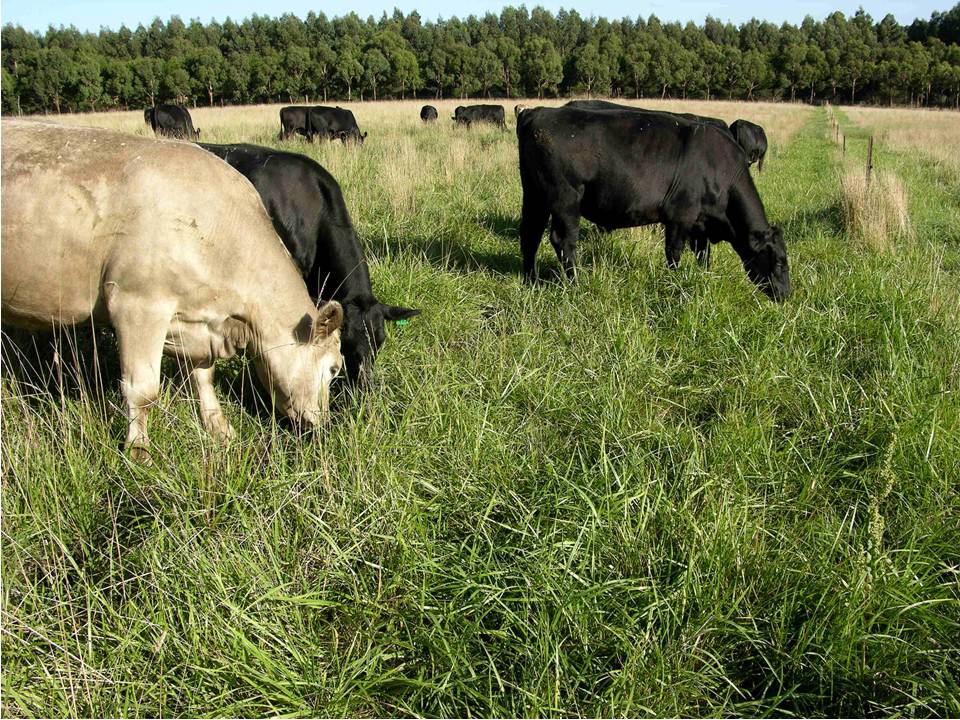Financial institutions are driving red meat sustainability demands
By James Nason
THE main drivers for reporting of sustainability credentials in Australian red meat value chains are not consumers but banks and Government, which are under pressure to implement their own sustainability reporting requirements, according to a newly published study.
“Little evidence was found that consumers are a driver of sustainability credentialling,” the newly published study states.
“The main drivers were in the global financial system, expressed in coordinated climate action policies by financial service providers and emerging government climate-related financial legislation.”
The study also recommends the red meat industry should “act urgently” to achieve recognition for climate metrics that differentiate the warming effect of short-lived biogenic methane emissions compared from carbon dioxide emissions.
The study, ‘Drivers of Sustainability Credentialling in the Red Meat Value Chain—A Mixed Methods Study’ was authored by CSIRO scientist Dr Bradley Ridoutt and published in the scientific journal ‘Agriculture’ on April 29.
It involved consultation with 10 Australian red meat processors and a review of existing research to explore drivers of sustainability credentialling from outside the value chain, and provides new insight into the influence of global policy making upon local value chains.
Requirements to transition to net zero greenhouse gas emissions, including the Federal Government’s proposed implementation of mandatory reporting of Scope 3 emissions in Australia, will mean most Australian red meat value chain participants, small and large, will be affected.
The paper says the transition to net zero greenhouse gas emissions presents many risks to red meat value chains, potentially involving costly interventions and more difficult access to financial services, with direct implications for production costs and asset values.
It recommends “urgent action” by the red meat industry to achieve formal recognition and use of climate metrics that differentiate warming effect of short-lived biogenic methane emissions compared from carbon dioxide emissions.

Figure: The red meat industry must emphasise it is not adding to CO2 stock in the atmosphere, rather the CO2 is in a constant flowing between the farm environment, livestock and the atmosphere.
“What is missing is an approach to climate action in red meat value chains that is commensurate with the greenhouse gas emissions profile which is dominated by short-lived biogenic methane.
“The climate stabilization objectives of the Paris Agreement can be met without reducing these emissions to net zero.
“Urgent action is recommended by the red meat industry to achieve the formal recognition and use of climate metrics that differentiate the management strategies that are needed for short-lived biogenic methane compared to CO2.
Dr Ridoutt has previously published research showing a target of “climate neutrality” is realistically achievable for the Australian red meat industry by 2026.
The latest study notes that examples of red meat products bearing sustainability credentials in the marketplace are relatively few, especially in Australia, even though interest in the sustainability of agricultural and food systems is said to be increasing at an exponential rate.
While there is some evidence that consumers are willing to pay more for meat products with sustainability credentials, the report notes, it says there is also that evidence points to the contrary.
“Overall, the evidence concerning a willingness to pay for meat products differentiated by sustainability credentialling is limited as it is mainly derived from choice experiments using hypothetical products rather than studies conducted in real consumer settings,” it says.
The study was based on a “multi-method research approach” which the author said was deemed appropriate, consisting of a combination of interviews and a literature review.
Australian red meat processors were asked what sustainability credentials are currently being provided, and to whom; what demands for sustainability credentials are likely to emerge in future; and to comment on perceived opportunities and risks associated with sustainability credentialling.
A recurring message from the study was that processors do not see value in product-level sustainability credentialling for consumers.

Figure: In numerous consumer surveys over many years the message to red meat farmers is that environmental credentials are important, in reality there is not enough demand from consumers for such credentials if a premium price must be paid. Environmental credentials are likely to be important for other benefits such as securing finance.
Comments received included: “Sustainability credentials are valued by few end consumers”, “End consumers not paying more”, and “Don’t see any premium for credentials for consumers”.
One processor remarked that they did not expect that carbon neutral red meat products would become more commonplace due to the increased costs and limited market opportunities.
The consultation with red meat processors revealed scant evidence that sustainability credentials are an opportunity for value creation for consumers.
The main exception was in the case of 100% grass-fed red meat products, for which a price premium exists in some markets and where sustainability credentials can enhance the overall value proposition to consumers.
Several processors highlighted consumer demand for premium 100% grass-fed red meat products and noted that, for these products, sustainability credentials were a supporting attribute.
This included sustainability credentials such as “free to roam”, implying a high standard of animal welfare, hormone and antibiotic free, and raised using regenerative agricultural practices.
Overwhelmingly, Australian red meat processors identified the main demand for sustainability credentialling as coming from large corporate entities in the value chain, from banks and other financial service providers, and from government.
“The common view about large corporate entities in the value chain was that sustainability credentialling was less about increasing value to red meat consumers and more about addressing their own requirements to report corporate sustainability information and to address corporate policies.

Figure: Consumers are more attracted in livestock welfare credentials such as “pasture fed” and “free to roam” than greenhouse gas emissions credentials which are generally harder for them to understand.
Processors also expressed the view that sustainability credentialling for large corporate entities, banks, and other financial service providers, and for government, was expected to increase and expand to include a wider range of environmental, social and governance aspects, and in particular, information about natural capital and biodiversity.
Aus banks active members of Net-Zero Banking Alliance
Data obtained from the sustainability reports of major financial institutions servicing the Australian agribusiness sector show all are active members of the UN-convened Net-Zero Banking Alliance (NZBA).
The NZBA involves a commitment to financing ambitious climate action and a commitment to supporting a transitioning of the economy to net-zero GHG emissions by 2050 through the management of their lending and investment portfolios.
The practical implication is that lending products are now being developed where the interest charges are linked to sustainability performance targets, and where lending is targeted directly to GHG emission reduction, such as the purchasing of lower-emission vehicles and machinery.
Banks are reporting annually on their financed emissions, whereby GHG emissions are attributed to the bank in proportion to their involvement in providing capital or financing.
For example, in the financial year 2022, CBA reported financed emissions of 22.3 Mt CO2e, of which 3.0 Mt CO2e was related to business lending to Australian agriculture and another 2.6 Mt CO2e was related to New Zealand agriculture.
Together, these emissions exceeded CBA’s financed emissions related to housing (4.4 Mt CO2e); commercial property (1.3 Mt CO2e); mining, oil, and gas (2.3 Mt CO2e); and manufacturing (3.0 Mt CO2e).
In addition, under the NZBA, banks are developing sector plans that are designed to transition their financed emissions to net zero by mid-century or sooner.
“What is interesting is that all major agribusiness banking service providers in Australia joined the NZBA within about 12 months of its foundation, and within 9 months of each other, suggesting that membership is beneficial for participation in global financial markets,” the study said.
“The NZBA is itself part of a larger initiative, the UNEP Finance Initiative, which can be considered an originating driver. The UNEP Finance Initiative also addresses insurance providers and asset managers; however, these sectors of the finance industry featured less prominently than banks in the consultation with red meat processors.”
Government regulation
In addition to finance sector drivers of sustainability credentialling, the consultation with red meat processors also identified emerging government regulation.
The Australian Government Treasury Department has proposed draft legislation with a phased implementation that in a short number of years will require businesses with an annual revenue of AUD 50 million and as few as 100 employees to report information about climate-related governance processes, transition planning and climate-related targets, and GHG emissions.

Figure: From 1 July 2024 some large businesses will be required to report on their climate credentials.
Many red meat processors in Australia would exceed these reporting thresholds, as would corporate food and grocery retailers.
The draft legislation require companies to disclose material Scope 3 emissions, which refer to emissions that occur in the value chain of the reporting entity.
For a red meat processor this would include the emissions associated with the farming system that produced the livestock, and, for a retailer of red meat, this would include GHG emissions associated with farming and processing.
This is likely to include the majority of Australian red meat value chain participants, with the only likely exceptions being small-scale livestock producers supplying local independent meat vendors.

Figure: Some of the large multi-national red meat processors are setting targets for emission reductions including from their supply chains. Here Cargill has set a 30% emission reduction by 2030 for its supply chain which includes farmer suppliers. Source: Cargill web site.
The study said the Australian framework of legislation around climate-related disclosure can be seen as a response to emerging international financial reporting developments that have arisen as a result of the work of the Task Force on Climate-Related Financial Disclosure established by the Financial Stability Board of the Bank of International Settlements (BIS), “which can be considered an originating driver”.
While opportunities for red meat value chains to benefit from sustainability credentialling may be few, the drivers from beyond the value chain present many risks, the study said.

“The risk is that increasingly, business-level decision making in the red meat value chain will be directly influenced by financial service providers,” the study says.
“It is also not out of the question that banks could rebalance their lending and investment portfolios away from red meat producers, making refinancing or the purchase of sheep- and cattle-producing farms difficult without large-scale interventions to mitigate or offset emissions through the sequestration of carbon in soils and vegetation.
“This would undoubtedly have implications for productivity, profitability, and the value of assets.”
Another risk is that smaller producers that are unable to comply with new reporting requirements will risk being left out of supply chains.
For large retailers, there may also be decisions taken to reduce Scope 3 emissions by downscaling the sale of red meat products in favor of lower-emission plant-based alternatives, thereby limiting channels to market for red meat producers.
“If emissions disclosures become publicly reported, this will also create an avenue for public activism designed to pressure large corporate retailers away from the red meat industry.

Figure: Once large processing businesses disclose their emissions even more pressure could be place on the red meat sector by anti-meat activists.
“Furthermore, government climate-related financial disclosure regulations will potentially underpin other forms of direct government intervention in industry.”
Another important observation was that the main drivers for sustainability credentialling are not local but originate in global policy making, arising from outside the value chain and creating the risk of interfering with normal processes of value chain operation that traditionally concern the efficient production of goods and services that are valued by consumers.
“What is emerging is a situation where financial institutions take autonomy away from value chains and consumers and make decisions about the pace and extent of social and environmental change.
“Moreover, the market for financial services in Australia is limited as all the major rural and agribusiness providers are part of the same global alliance (NZBA and UNEP PRB). As such, banks and other financial institutions become the change-makers, an outcome deemed desirable by some, but which nonetheless represents a risk to red meat producers as decision making about social and environmental matters becomes externalized and centralized.”
GHG accounting schemes ‘a matter of major consequence’
The study notes that red meat industry emissions are unlike most other industries in that the main GHG emission is biogenic methane.
How biogenic methane emissions are addressed in GHG accounting schemes is therefore a matter of major consequence, it says.
In the case of the NZBA, methane and other non-CO2 emissions are converted to CO2-equivalent emissions using 100-year global warming potentials.
“It is critical to note that there is no scientific argument for selecting this basis of equivalency: it is a value choice.
“There is no absolute equivalence in the climate impact of two different GHGs, as each GHG has its particular radiative forcing characteristics and atmospheric lifetime.
“Depending on the climate metric chosen, the relative importance of different GHGs varies, so much so that reported results and conclusions can be dramatically changed.
“While the choice of climate metric may be a small matter for industries where non-CO2 emissions are of minor importance, the issue is of major consequence for the red meat industry.”
Regarding the Paris Agreement goal of stabilizing the climate, the Intergovernmental Panel on Climate Change (IPCC) has in recent years drawn greater attention to the need for different management strategies for short-lived GHGs, like methane, compared to CO2 and other GHGs with long atmospheric lifetimes.
The study says there is a strong case for the use of climate metrics in the red meat industry that better reflect the warming potential of biogenic methane over time.
Two such metrics have been proposed: the GWP* and the radiative forcing (RF) footprint.
These metrics enable a more transparent reporting of climate impact and alignment with the goal of climate stabilization, reflecting the need to reduce long-lived GHG emissions to net zero and the need to manage the rate of methane emission such that there is no additional contribution to warming.
“The implications for the industry are enormous, as any requirement to reduce red meat industry biogenic methane emissions to net zero will not only be extraordinarily costly, but unnecessary to achieve alignment with the Paris Agreement.
“It should be a matter of urgency for the red meat industry to achieve formal recognition of climate metrics that are applicable to the industry’s standing as a predominantly non-CO2 emitter.”
Source: Beef Central 6 May 2024. Images and captions added by Patrick Francis, they are not part of the original paper or the Beef Central story.
Original paper published 29 April 2024:
Ridoutt, B. Drivers of Sustainability Credentialling in the Red Meat Value Chain—A Mixed Methods Study. Agriculture 2024, 14, 697. https://doi.org/10.3390/ agriculture14050697




